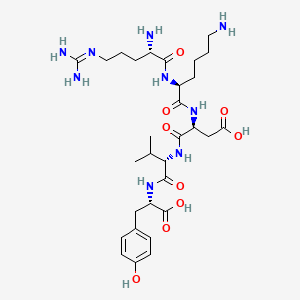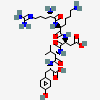Thymopentin
- THYMOPENTIN
- 69558-55-0
- TP-5
- Timunox
- Arg-Lys-Asp-Val-Tyr
- Create:2005-08-01
- Modify:2025-01-11


- Pentapeptide, Thymopoietin
- Thymopentin
- Thymopoietin Pentapeptide
- Timunox
- TP-5
- THYMOPENTIN
- 69558-55-0
- TP-5
- Timunox
- Arg-Lys-Asp-Val-Tyr
- Sintomodulina
- Thymopoietin 32-36
- IMMUNOX
- Hg-thymopentin
- Pentapeptide-1
- Thymopoietin pentapeptide
- Oristar thymopentin
- Sh-pentapeptide-1
- ORF-15244
- DTXSID9046609
- NSC-760116
- Thymopentine
- Thymopentinum
- Timopentina
- (6S,9S,12S,15S,18S)-1,6-diamino-9-(4-aminobutyl)-12-(carboxymethyl)-18-(4-hydroxybenzyl)-1-imino-15-isopropyl-7,10,13,16-tetraoxo-2,8,11,14,17-pentaazanonadecan-19-oic acid
- DTXCID7026609
- Thymopoetin 32-36-pentapeptide
- ORF 15244
- L-Tyrosine, L-arginyl-L-lysyl-L-a-aspartyl-L-valyl-
- Thymopentine [French]
- Thymopentinum [Latin]
- Timopentina [Spanish]
- (3S)-3-[[(2S)-6-amino-2-[[(2S)-2-amino-5-(diaminomethylideneamino)pentanoyl]amino]hexanoyl]amino]-4-[[(2S)-1-[[(1S)-1-carboxy-2-(4-hydroxyphenyl)ethyl]amino]-3-methyl-1-oxobutan-2-yl]amino]-4-oxobutanoic acid
- Thymopentin [USAN:INN:BAN]
- Thymopentinum (Latin)
- Pentapeptide, Thymopoietin
- O3Y80ZF13F
- Thymopentin Acetate (TP-5)
- NSC645363
- N-(N-(N-(N(2)-L-Arginyl-L-Lysyl)-L-alpha-Aspartyl)-L-Valyl)-L-Tyrosine
- N-[N-[N-(N{2}-L-Arginyl-L-lysyl)-L-alpha-aspartyl]-L-valyl]-L-tyrosine
- L-Tyrosine, N-(N-(N-(N2-L-arginyl-L-lysyl)-L-alpha-aspartyl)-L-valyl)-
- NSC 760116
- Thymopentin,(S)
- NCGC00166412-01
- (3S)-3-(((2S)-6-amino-2-(((2S)-2-amino-5-(diaminomethylideneamino)pentanoyl)amino)hexanoyl)amino)-4-(((2S)-1-(((1S)-1-carboxy-2-(4-hydroxyphenyl)ethyl)amino)-3-methyl-1-oxobutan-2-yl)amino)-4-oxobutanoic acid
- TP-5 Acetate
- MFCD00214200
- RKDVY
- THYMOPENTIN [MI]
- THYMOPENTIN [INN]
- Thymopentin (USAN/INN)
- THYMOPENTIN [USAN]
- SCHEMBL44001
- THYMOPENTIN [WHO-DD]
- MLS000069768
- Arg-Lys-Asp-Val-Tyr; RKDVY
- CHEMBL156025
- Thymopentin, >=97% (HPLC)
- L03AX09
- CHEBI:135870
- PSWFFKRAVBDQEG-YGQNSOCVSA-N
- SH-PENTAPEPTIDE-1 [INCI]
- HMS2231E14
- HMS3264A15
- Pharmakon1600-01506200
- HY-N7122
- Tox21_112420
- NSC760116
- AKOS015994638
- CCG-270365
- HS-2029
- SMP1_000105
- SMR000058921
- CAS-69558-55-0
- CS-0020412
- S3668
- imino-15-isopropyl-7,10,13,16-tetraoxo-
- 12-(carboxymethyl)-18-(4-hydroxybenzyl)-1-
- D06117
- 2,8,11,14,17-pentaazanonadecan-19-oic acid
- Q7799637
- BRD-K52097716-001-01-1
- L-Tyrosine, L-arginyl-L-lysyl-L-alpha-aspartyl-L-valyl-
- (6S,9S,12S,15S,18S)-1,6-diamino-9-(4-aminobutyl)-
- L-Tyrosine, L-arginyl-L-lysyl-L-.alpha.-aspartyl-L-valyl-
- (3S)-3-[(2S)-6-AMINO-2-[(2S)-2-AMINO-5-CARBAMIMIDAMIDOPENTANAMIDO]HEXANAMIDO]-3-{[(1S)-1-{[(1S)-1-CARBOXY-2-(4-HYDROXYPHENYL)ETHYL]CARBAMOYL}-2-METHYLPROPYL]CARBAMOYL}PROPANOIC ACID
- (6S,9S,12S,15S,18S)-1,6-diamino-9-(4-aminobutyl)-12-(carboxymethyl)-18-(4-hydroxybenzyl)-1-imino-15-isopropyl-7,10,13,16-tetraoxo-2,8,11,14,17-pentaazanonadecan-19-oicacid

H315 (100%): Causes skin irritation [Warning Skin corrosion/irritation]
H319 (100%): Causes serious eye irritation [Warning Serious eye damage/eye irritation]
H335 (100%): May cause respiratory irritation [Warning Specific target organ toxicity, single exposure; Respiratory tract irritation]
P261, P264, P264+P265, P271, P280, P302+P352, P304+P340, P305+P351+P338, P319, P321, P332+P317, P337+P317, P362+P364, P403+P233, P405, and P501
(The corresponding statement to each P-code can be found at the GHS Classification page.)
Skin Irrit. 2 (100%)
Eye Irrit. 2 (100%)
STOT SE 3 (100%)
Patents are available for this chemical structure:
https://patentscope.wipo.int/search/en/result.jsf?inchikey=PSWFFKRAVBDQEG-YGQNSOCVSA-N
- ChEBI
- DrugBankLICENSECreative Common's Attribution-NonCommercial 4.0 International License (http://creativecommons.org/licenses/by-nc/4.0/legalcode)https://www.drugbank.ca/legal/terms_of_useThymopentinhttps://www.drugbank.ca/drugs/DB11996
- NCI Thesaurus (NCIt)LICENSEUnless otherwise indicated, all text within NCI products is free of copyright and may be reused without our permission. Credit the National Cancer Institute as the source.https://www.cancer.gov/policies/copyright-reuseNCI Thesaurushttps://ncit.nci.nih.gov
- Open TargetsLICENSEDatasets generated by the Open Targets Platform are freely available for download.https://platform-docs.opentargets.org/licence
- ChEMBLLICENSEAccess to the web interface of ChEMBL is made under the EBI's Terms of Use (http://www.ebi.ac.uk/Information/termsofuse.html). The ChEMBL data is made available on a Creative Commons Attribution-Share Alike 3.0 Unported License (http://creativecommons.org/licenses/by-sa/3.0/).http://www.ebi.ac.uk/Information/termsofuse.htmlChEMBL Protein Target Treehttps://www.ebi.ac.uk/chembl/g/#browse/targets
- ClinicalTrials.govLICENSEThe ClinicalTrials.gov data carry an international copyright outside the United States and its Territories or Possessions. Some ClinicalTrials.gov data may be subject to the copyright of third parties; you should consult these entities for any additional terms of use.https://clinicaltrials.gov/ct2/about-site/terms-conditions#Use
- Comparative Toxicogenomics Database (CTD)LICENSEIt is to be used only for research and educational purposes. Any reproduction or use for commercial purpose is prohibited without the prior express written permission of NC State University.http://ctdbase.org/about/legal.jsp
- Therapeutic Target Database (TTD)
- DTP/NCILICENSEUnless otherwise indicated, all text within NCI products is free of copyright and may be reused without our permission. Credit the National Cancer Institute as the source.https://www.cancer.gov/policies/copyright-reuse
- EPA DSSToxCompTox Chemicals Dashboard Chemical Listshttps://comptox.epa.gov/dashboard/chemical-lists/
- European Chemicals Agency (ECHA)LICENSEUse of the information, documents and data from the ECHA website is subject to the terms and conditions of this Legal Notice, and subject to other binding limitations provided for under applicable law, the information, documents and data made available on the ECHA website may be reproduced, distributed and/or used, totally or in part, for non-commercial purposes provided that ECHA is acknowledged as the source: "Source: European Chemicals Agency, http://echa.europa.eu/". Such acknowledgement must be included in each copy of the material. ECHA permits and encourages organisations and individuals to create links to the ECHA website under the following cumulative conditions: Links can only be made to webpages that provide a link to the Legal Notice page.https://echa.europa.eu/web/guest/legal-notice
- New Zealand Environmental Protection Authority (EPA)LICENSEThis work is licensed under the Creative Commons Attribution-ShareAlike 4.0 International licence.https://www.epa.govt.nz/about-this-site/general-copyright-statement/
- Japan Chemical Substance Dictionary (Nikkaji)
- KEGGLICENSEAcademic users may freely use the KEGG website. Non-academic use of KEGG generally requires a commercial licensehttps://www.kegg.jp/kegg/legal.htmlAnatomical Therapeutic Chemical (ATC) classificationhttp://www.genome.jp/kegg-bin/get_htext?br08303.keg
- Metabolomics Workbench
- NORMAN Suspect List ExchangeLICENSEData: CC-BY 4.0; Code (hosted by ECI, LCSB): Artistic-2.0https://creativecommons.org/licenses/by/4.0/ThymopentinNORMAN Suspect List Exchange Classificationhttps://www.norman-network.com/nds/SLE/
- Springer Nature
- WHO Anatomical Therapeutic Chemical (ATC) ClassificationLICENSEUse of all or parts of the material requires reference to the WHO Collaborating Centre for Drug Statistics Methodology. Copying and distribution for commercial purposes is not allowed. Changing or manipulating the material is not allowed.https://www.whocc.no/copyright_disclaimer/
- Wikidatathymopentinhttps://www.wikidata.org/wiki/Q7799637
- WikipediaThymopentinhttps://en.wikipedia.org/wiki/Thymopentin
- Medical Subject Headings (MeSH)LICENSEWorks produced by the U.S. government are not subject to copyright protection in the United States. Any such works found on National Library of Medicine (NLM) Web sites may be freely used or reproduced without permission in the U.S.https://www.nlm.nih.gov/copyright.htmlThymopentinhttps://www.ncbi.nlm.nih.gov/mesh/68016305Adjuvants, Immunologichttps://www.ncbi.nlm.nih.gov/mesh/68000276
- PubChem
- GHS Classification (UNECE)GHS Classification Treehttp://www.unece.org/trans/danger/publi/ghs/ghs_welcome_e.html
- MolGenieMolGenie Organic Chemistry Ontologyhttps://github.com/MolGenie/ontology/
- PATENTSCOPE (WIPO)SID 388447910https://pubchem.ncbi.nlm.nih.gov/substance/388447910
